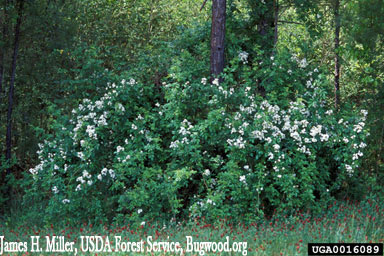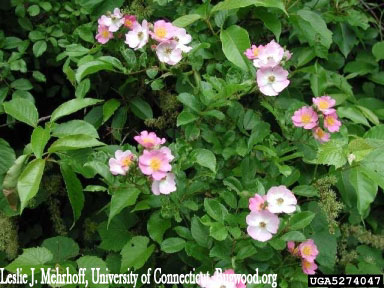Multiflora Rose
(Rosa multiflora)
Family: Rose family (Rosaceae)
Native Range: Eastern China, Japan, Korea
 Multiflora rose is a thorny, perennial shrub with arching stems (canes), and leaves divided into five to eleven sharply toothed leaflets. The base of each leaf stalk bears a pair of fringed bracts. Beginning in May or June clusters of showy, fragrant, white to pink flowers appear, each about an inch across. Small bright red fruits, or rose hips, develop during the summer, becoming leathery, and remain on the plant through the winter.
Multiflora rose is a thorny, perennial shrub with arching stems (canes), and leaves divided into five to eleven sharply toothed leaflets. The base of each leaf stalk bears a pair of fringed bracts. Beginning in May or June clusters of showy, fragrant, white to pink flowers appear, each about an inch across. Small bright red fruits, or rose hips, develop during the summer, becoming leathery, and remain on the plant through the winter.
Look-alikes
- Scotch rose (Rosa spinosissima L.)
- memorial rose (Rosa wichuraiana Crepin)
Rosa multiflora is distinguished from other roses by the feathery or comb-like margin on its stipules (a narrow, green, leaf-like structure located at the base of each leaf stalk). Rosa spinosissima has a profuse amount of narrow, needle-like thorns on its branches. Rosa wichuraiana is a low-growing rose that often covers the ground.
Ecological Threat
Multiflora rose is extremely prolific and can form impenetrable thickets that exclude native plant species. This exotic rose readily invades open woodlands, forest edges, successional fields, savannas and prairies that have been subjected to land disturbance.
Distribution and Background
Multiflora rose was introduced to the East Coast from Japan in 1866 as rootstock for ornamental roses. Beginning in the 1930s, the U.S. Soil Conservation Service promoted it for use in erosion control and as “living fences” to confine livestock. State conservation departments soon discovered value in multiflora rose as wildlife cover for pheasant, bobwhite quail, and cottontail rabbit and as food for songbirds and encouraged its use by distributing rooted cuttings to landowners free of charge. More recently, multiflora rose has been planted in highway median strips to serve as crash barriers and to reduce automobile headlight glare. Its tenacious and unstoppable growth habit was eventually recognized as a problem on pastures and unplowed lands, where it disrupted cattle grazing.
Multiflora rose occurs throughout the U.S., with the exception of the Rocky Mountains, the southeastern Coastal Plain and the deserts of California and Nevada.
Multiflora rose has a wide tolerance for various soil, moisture, and light conditions. It occurs in dense woods, prairies, along stream banks and roadsides and in open fields and pastures.
Alternative Plants (Alternative native Species)
Using native shrubs and trees for land restoration and landscaping can prevent invasions by multiflora rose.
Whenever possible, use as alternatives plant species that are native and adapted to the ecological region where you live. They will be more valuable to the wildlife species that have evolved with them and depend upon them for food and shelter. Check with your local native plant society for recommendations and sources of native plants.
Biology and Spread
 Multiflora rose reproduces by seed and by forming new plants that root from the tips of arching canes that contact the ground. Fruits are readily sought after by birds which are the primary dispersers of its seed. An average multiflora rose plant may produce a million seeds per year. The seeds can remain viable in the soil for up to twenty years. Germination of multiflora rose seeds is enhanced by passing through the digestive tract of birds.
Multiflora rose reproduces by seed and by forming new plants that root from the tips of arching canes that contact the ground. Fruits are readily sought after by birds which are the primary dispersers of its seed. An average multiflora rose plant may produce a million seeds per year. The seeds can remain viable in the soil for up to twenty years. Germination of multiflora rose seeds is enhanced by passing through the digestive tract of birds.
Management Options
Mechanical and chemical methods are effective methods for managing multiflora rose but may need to be combined with chemical in large or persistent infestations.
For disposal options, refer to the control methods and disposal options page.
Plant Control
The most important steps to controlling multiflora rose are to destroy existing plants and begin a yearly program to control seedlings as they appear.
Biological
Biological control is not yet available for management of multiflora rose. However, researchers are investigating several options, including a native viral pathogen (rose-rosette disease), which is spread by a tiny native mite, and a seed-infesting wasp, the European rose chalcid.
Manual and Mechanical
Frequent, repeated cutting or mowing three to six times per growing season for two to four years is effective in achieving high mortality of multiflora rose. In high quality natural communities, cut the individual plants to minimize habitat disturbance.
Chemical
Herbicides are successful in controlling multiflora rose but follow-up treatments are required because of the long-lived stores of seed in the soil. Apply systemic herbicides (such as glyphosate) late in the growing season to freshly cut stumps or to regrowth. In wetlands, where multiflora rose may occur, make sure to use a wetland-formulated glyphosate product such as Rodeo or Accord Concentrate. Use an active ingredient concentration of 25-35% when you apply herbicide to the cut stem. Plant growth regulators control the spread of multiflora rose by preventing fruit set.
Caution: Applying herbicides to control invasive plants on property you do not personally own requires a pesticide applicator’s license issued by the state. A pesticide applicator’s license is required to use herbicides on public and private conservation lands.
Caution: Any activities in wetlands (from removing invasives by hand or by applying herbicides) may require a special permit under the Wetlands Protection Act and/or your local bylaws. Be sure to contact your local Conservation Commission before you act.
Always read the herbicide label before use. Never use more herbicide than recommended, or damage to desirable plants may result. Follow directions carefully. The container label will list plants for which that herbicide has been approved. Since registration status of pesticides is reviewed continuously and is subject to change, read the product label before purchasing to make sure it is registered for your need. To use a product in any way that is inconsistent with the label is in violation of the Federal Environmental Pesticide Act of 1972.
Notice: Mention Of Pesticide Products On This Web Site Does Not Constitute Endorsement Of Any Material.
More Information
For more information on invasive species in Massachusetts, refer to the Massachusetts Prohibited Plant List at https://www.mass.gov/massachusetts-prohibited-plant-list.
Authors
Carole Bergmann, Montgomery County Department of Parks, Silver Spring, MD
Jill M. Swearingen, National Park Service, Washington, DC
References
Albaugh, G.P., W.H. Mitchell, and J.C. Graham. 1977. Evaluation of glyphosate for multiflora rose control. Proceedings of the New England Weed Science Society, vol. 31, pp. 283-291.
Amrine, J.W., Jr. and T.A. Stasny. 1993. Biological control of multiflora rose. Pp. 9-21. In McKnight, B.N.(ed.). Biological Pollution. Indiana Acad. Sci., Indianapolis. 261 pp.
Evans, J.E. 1983. A literature review of management practices for multiflora rose (Rosa multiflora). Natural Areas Journal 3(1):6-15.
Fawcett, R.S. 1980. Today’s weed–multiflora rose. Weeds Today 11: 22-23.
Swearingen, J. 2009. WeedUS Database of Plants Invading Natural Areas in the United States: Multiflora Rose (Rosa multiflora). http://www.invasive.org/weedus/subject.html?sub=3071.
Szafone, R. 1991. Vegetation Management Guidelines: Multiflora rose (Rosa multiflora Thunb.). Natural Areas Journal 11(4):215-216.
The Nature Conservancy. Multiflora Rose: Element Stewardship Abstract. In: Wildland Weeds Management & Research Program, Weeds on the Web.
USDA, NRCS. 2009. The PLANTS Database (http://plants.usda.gov). National Plant Data Center, Baton Rouge, LA 70874-4490 USA.
Wyman, D. 1949. Shrubs and vines for American gardens. New York: MacMillan Co., 613 pp.
Plant Conservation Alliance, Alien Plant Working Group https://www.invasive.org/species/weeds.cfm